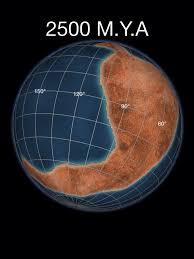This article needs additional citations for verification. (December 2016) |
 Map of Kenorland supercontinent 2.5 billion years ago[citation needed] | |
| Historical continent | |
|---|---|
| Formed | 2.72 Ga |
| Type | Supercontinent |
| Today part of | [1] |
Kenorland is a hypothetical Neoarchean supercontinent. If it existed, it would have been one of the earliest known supercontinents on Earth. It is thought to have formed during the Neoarchaean Era c. 2.72 billion years ago (2.72 Ga) by the accretion of Neoarchaean cratons and the formation of new continental crust. It comprised what later became Laurentia (the core of today's North America and Greenland), Baltica (today's Scandinavia and Baltic), Western Australia and Kalaharia.[1]
Swarms of volcanic dikes and their paleomagnetic orientation as well as the existence of similar stratigraphic sequences permit this reconstruction. The core of Kenorland, the Baltic/Fennoscandian Shield, traces its origins back to over 3.1 Ga. The Yilgarn Craton (present-day Western Australia) contains zircon crystals in its crust that date back to 4.4 Ga.
Kenorland was named after the Kenoran orogeny (also called the Algoman orogeny),[2] which in turn was named after the town of Kenora, Ontario.[3]
- ^ a b Pesonen et al. 2003, Abstract
- ^ Salminen, Johnna; Pehrsson, Sally; Evans, David A.D.; Wang, Chong (2021). "Neoarchean-Paleoproterozoic supercycles". In Pesonen, Lauri J.; Salminen, Johanna; Elming, Sten-Ake; Evans, David A.D.; Veikkolainen, Toni (eds.). Ancient Supercontinents and the Paleogeography of Earth. Elsevier. p. 466. ISBN 0128185341.
- ^ Gower, Charles F.; Clifford, Paul M. (1981). "The structural geometry and geological history of Archean rocks at Kenora, north-western Ontario—a proposed type area for the Kenoran Orogeny". Canadian Journal of Earth Sciences.